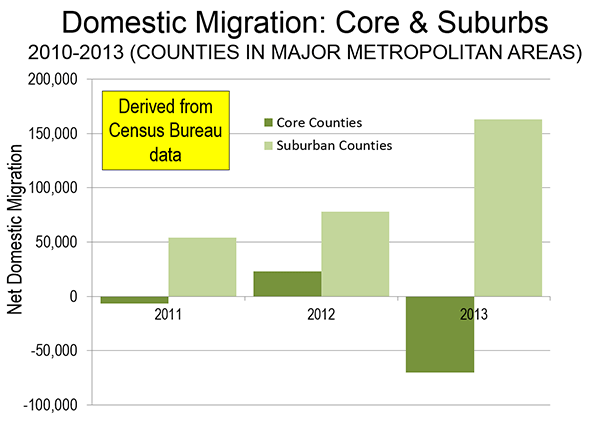NewGeography.com blogs
A New York Times article by Sam Roberts indicates that
"According to Census Bureau estimates released last week, in the year ending July 1, 2013, the city recorded the third consecutive gain in its non-Hispanic white population.
During that same period, the city gained more people than it lost through migration. Neither of those gains has probably happened since the 1960s, according to demographers."
It is true that net migration, domestic and international, was positive between 2012 and 2013. However, net migration was also positive in the years ended 2012 and 2011, according to Census Bureau data. Among the three recent years, the lowest net migration total was in 2013 (Table).
| New York City Net Migration: 2011-2013 |
| Year |
Domestic |
International |
Combined |
| 2011 |
(55,807) |
69,076 |
13,269 |
| 2012 |
(64,383) |
71,752 |
7,369 |
| 2013 |
(67,629) |
73,615 |
5,986 |
| Total |
(187,819) |
214,443 |
26,624 |
| Data from Census Bureau |
|
Further, net domestic migration has continued to be negative. The city has lost a net 187,000 domestic migrants in the first three years of the decade. This is an average of more than 60,000 annually. This is, however, an improvement from the 2000s, when net domestic migration averaged a minus 135,000.
Today, there are about 30 megacities in the world, where more than 10 million residents live. The largest is Tokyo, at about 38 million. Recent announcements by the government of China could lead to the worlds' first gigacity (for want of a better term, used here to denote a city of more than 100,000,000 population, see note). According to the Nanfang Insider, the economic integration of megacity Beijing, megacity Tianjin and eight cities (prefectures) in the province of Hebei would result in a city of 130 million. China Daily is a bit more circumspect, indicating that the Beijing supercity would have only 85 million.
The giga/super city would be tied together by new rapid transit lines and highways and surrounded by the 7th Ring Road, adding to the six that have already been built. The 7th Ring Road would consist of two roads, circling most of the area, and extending to a combined 850 miles (2,200 kilometers). By comparison, London's M-25 is 117 miles long (188 kilometers), the Moscow MKAD 68 miles long (109 kilometers) and the Washington beltway is 64 miles long (103 kilometers)
The giga or super city is not likely to really be a city, because it would be much larger than a labor market (this is why the near continuous urbanization from Boston to Washington or Tokyo to Osaka-Kobe-Kyoto is not a city). The estimated land area is 67,000 square miles (175,000 square kilometers). This is nearly as large as Cambodia or the state of Oklahoma. Providing the point to point daily commuting in such a large area is well beyond the capability of any affordable transportation system. Star Trek like teleportation could do the trick. Meanwhile, however, there is plenty to be gained from the economic integration of this large area.
Graphic of the new 7th ring road from nanfang.com:

Note: Technically, a gigacity would need 1 billion people (10 to the 9th power). However, megacities, with their 10 million minimum are also wrongly named. A city with a mega city would have 1,000,000 people (10 to the 6th power). Artistic license justifies the gigacity term under the circumstances. Besides, with the slowing growth of world population, it seems unlikely than any city will achieve a population of 1 trillion.
It seems that Destination LI, “a nonprofit community building and educational organization dedicated to helping people create and sustain vibrant centers” on Long Island, has been quietly busy in recent months.
Recently, the group released a survey, which, to nobody’s surprise, shows that millennials are not exactly thrilled with Long Island’s housing options.
The solution? Those “vibrant” walkable communities that have been pitched so many times before. The survey also touched upon Long Island’s need for jobs that match millennial skillsets and salary expectations, two critical issues that policymakers must address.
In a nutshell, “the survey, conducted on social media web forums between Feb. 27 and March 24, drew 413 respondents.” To solicit responses, the group used sites such as Facebook, Twitter, LinkedIn, Reddit and others. Seventy-five percent of those who participated said that they either “agree” or “strongly agree” that Long Island’s housing options limit their ability to stay, with 58.7 percent saying they currently live with parents or relatives.
For perspective, consider this: According to U.S. Census data from 2010, there were 478,988 millennials in the Nassau-Suffolk region. Destination LI’s survey of 413 represents 0.08 percent of the sample size – far from a representative sample of that segment of population. Given the large gap between population and those surveyed online (which, by surveying standards, is a poor solicitation method), it’s important to take the results for what they are – anecdotal, but still an important commentary. Long Island clearly has issues with providing housing, but we’re going about it the wrong way.
The survey brings to light significant questions concerning Long Island. Is regional housing availability holding millennials back, or is it Long Island’s stagnant economy? The survey infers that walkable apartments keep millennials here, but what about affordable single-family homes? Are apartments the only housing option for this age group? Is more development the answer to our regional woes? Are the survey’s findings legitimate given the methodology?
Finally, the big question remains: Should developers be driving the regional conversation on housing needs?
The answer to any of these questions is up for debate, but the last one should resonate. Have Long Islanders become so apathetic that they now are reliant upon stakeholders to conduct surveys that not only get ample press coverage, but are sure to influence policy decisions on the regional level? Shouldn’t planners be conducting these studies, with their recommendations being based off appropriate methodology and professionalism?
Our policy solutions are only as good as the data that informs them. With land-use, the cost of failure is too expensive and repercussions too severe and far reaching to rely on stakeholder-driven solutions. We all are leaders in that we have the power to collectively shape our community. Let’s take back the reins and give our problems the thoughtful analysis they deserve.
Christine Lagarde, the Managing Director of the International Monetary Fund cited the need for housing market reform at the conclusion of discussions with the government of the United Kingdom on Friday, June 6.
The housing market in the United Kingdom has experienced a long and continuing escalation in prices relative to incomes, largely due to the nation's strict urban containment policies that date from the 1947 Town and Country Planning Act, and significant further restrictions put in place during the Blair government.
According to Ms. Lagarde:
"But rising house prices fundamentally reflect demand that greatly exceeds supply. Addressing imbalances in the housing market by alleviating supply-side constraints will require further measures to increase the availability of land for development and to remove unnecessary constraints on land use."
The Daily Mail further reported that Ms. Lagarde "called for ‘unnecessary’ restrictions on building on greenfield sites to be lifted, so the supply of houses can be increased. This, she said, would help stabilise prices.
The United Kingdom's restrictive land use regulations have been a model for restrictive land use regimes from Sydney to Vancouver, Auckland, Portland and California. They have been responsible for driving up house prices relative to incomes, which reduces household discretionary incomes. The result is lower standards of living and higher rates of poverty. London School of Economics professor Paul Cheshire has concluded that urban containment policy is irreconcilable with housing affordability.
|














